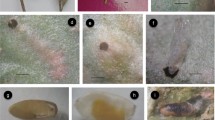Abstract
Dasineura oleae is a gall midge on leaves and branches of olive trees. Due to the scarcity of information regarding to the infestation and phenology of D. oleae on olive trees, the objectives of this research were: (1) to study the pest status of D. oleae and its damage on olive trees, (2) to describe the life stages: egg, larva, pupa and adult, (3) to determine the life cycle duration and number of generations per year and (4) to describe the egg laying, larval development, pupation and adult emergence. Results indicated that there was an outbreak of D. oleae in the Palestinian Territories where the average rate of infestation on olive trees was 51.46% and the damage caused by the insect on leaves, branches and inflorescence of infested trees reached at an average infestation rate of 35.88, 22.70 and 26.54%, respectively. Eggs of D. oleae were laid on the lower leaf surface, and the hatched larvae penetrated the tissues underneath and induced galls in which they live and develop until the emergence of adults. D. oleae developed one generation per year in the hilly regions of Palestinian Territories and two generations in the coastal regions of these territories. A full description of the life stages has been provided for the insect. In conclusion, this study provides with new information regarding to the pest status of D. oleae, infestation and development of the insect on the different organs of olive trees. These findings are necessary for the insect management and its control.


Similar content being viewed by others
References
Al-Tamimi MMA (1997) Population trends of olive leaf midge Dasineura oleae Loew (Diptera: Cecidomyiidae) and the effect of some insecticides on the midge and its parasites in Amman district. NCARE, Jordan, p 77
Avidov Z, Harpaz I (1969) Plant pest of Israel. Israel University Press, Jerusalem, p 549
Carango P, McCrea KD, Abrahamson WG, Chernin MI (1988) Induction of a 58,000 Dalton protein during goldenrod gall formation. Biochem Biophys Res Commun 152:1348–1358
Darvas B, Skuhravá M, Andersen A (2000) Agricultural Dipteran pests of the Palaearctic region. In: Darvas B (ed) Contributions to a manual of Palaearctic Diptera, general and applied dipterology. Science Herald, Budapest, pp 565–650
Doğanlar M, Sertkaya E, Skuhrava M (2011) Pest status of olive leaf gall midge Dasineura oleae (Angelini, 1831), description of Lasioptera oleicola Skuhravá sp. new (Diptera: Cecidomyiidae) and effectiveness of parasitoids on their populations in Hatay, Turkey. Turk Entomol Derg-TU 35:265–284
Farmer EF (2000) Potent mitogenic lipids from gall-inducing insects. Trends Plant Sci 5:359–360
Gagné RJ, Jaschhof M (2014) A catalog of the Cecidomyiidae (Diptera) of the World, 3rd ed., Digital version 2
Gerson V, Harpaz I (1968) Notes on gall-midges from Israel and their parasites. Entomol Bericht Amst 28:144–148
Haarder S, Bruun HH, Harris KM, Skuhravá M (2016) Gall midges (Diptera: Cecidomyiidae) new to the Danish fauna. Ent Tidskr 137:79–98
Harper LJ, Schönrogge K, Lim KY, Francis P, Lichtenstein CP (2004) Cynipid galls: insect-induced modifications of plant development create novel plant organs. Plant Cell Environ 27:327–335
Hrncic S (1998) A survey of olive pests in Montenegro. IV International symposium on olive growing. ISHS Acta Hortic 586:23–28
Perdikis D, Arvaniti K, Malliaraki S, Angelak A (2015) The outbreak of the olive leaf gall midge populations and the importance of indigenous natural enemies in its control. In: lOBC/wprs WG (eds) Integrated protection of olive crops. 7th Meeting, Kalamata, Greece 11–14 May 2015
PMA (Palestinian Ministry of Agriculture) (2017) Department of Statistics. Palestinian Authority, Ramallah, p 50
Raman A (1991) Cecidogenesis of leaf galls on Syzygium cumini (L.) Skeels (Myrtaceae) induced by Trioza jambolanae Crawford (Homoptera: Psylloidea). J Nat Hist 25:653–663
Rivnay D (1962) Field crop pests in the Near East, vol 10. Springer, Dordrecht, p 450. https://doi.org/10.1007/978-94-017-1544-7
Rowley C, Cherrill AJ, Leather SR, Hall DR, Rope TW (2018) Factors affecting trap catch in pheromone-based monitoring of saddle gall midge Haplodiplosis marginata (Diptera: Cecidomyiidae). Pest Manag Sci 74(2):406–412. https://doi.org/10.1002/ps.4721 Epub 2017 Oct 16
Schmid RB, Knutson A, Giles KL, McCornack BP (2018) Hessian Fly (Diptera: Cecidomyiidae) biology and management in wheat. J Integr Pest Manag 9(1):1–12. https://doi.org/10.1093/jipm/pmy008
Simoglou KB, Karataraki A, Roditakis NE, Roditakis E (2012) Euzophera bigella (Zeller) (Lepidoptera: Pyralidae) and Dasineura oleae (F. Low) (Diptera: Cecidomyiidae): emerging olive crop pests in the Mediterranean. J Pest Sci 85:169–177
Straka JR, Hayward AR, Neil-Emery RJ (2010) Gall-inducing Pachypsylla celtidis (Psyllidae) infiltrate hackberry trees with high concentrations of phytohormones. J Plant Interact 5:197–203
Acknowledgements
I would like to thank Dr. Marcela Skuhrava from Czech Zoological Society for identification of the insect as Dasineura oleae. Many thanks for my colleagues in the Department of Plant Production and Protection, An-Najah National University who helped in copyediting the manuscript. I would not forget to thank the anonymous reviewers who revised the manuscript and provided useful comments.
Author information
Authors and Affiliations
Contributions
The authors collected the samples of insect then carried out the assessment of its pest status and the damage caused by the insect. They carried out the description of life stages and other aspects of infestation and development of the insect. They prepared the manuscript and revised it.
Corresponding author
Ethics declarations
Conflict of interest
The authors declare that they have no conflict of interest.
Ethical standards
The authors comply with ethical standards.
Rights and permissions
About this article
Cite this article
Batta, Y.A. New findings on infestation and phenology of Dasineura oleae Angelini (Diptera, Cecidomyiidae): an emerging pest on olive trees in the Palestinian Territories. J Plant Dis Prot 126, 55–66 (2019). https://doi.org/10.1007/s41348-018-0196-y
Received:
Accepted:
Published:
Issue Date:
DOI: https://doi.org/10.1007/s41348-018-0196-y




